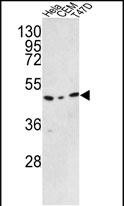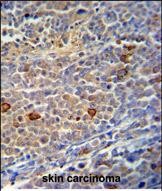

| WB | 1/1000 | Human,Mouse,Rat |
| IF | 咨询技术 | Human,Mouse,Rat |
| IHC | 1/100-1/500 | Human,Mouse,Rat |
| ICC | 技术咨询 | Human,Mouse,Rat |
| FCM | 咨询技术 | Human,Mouse,Rat |
| Elisa | 咨询技术 | Human,Mouse,Rat |
| Aliases | Nef-associated protein 1, 312-, Thioesterase NAP1, C9orf156, NAP1 |
| Entrez GeneID | 51531 |
| WB Predicted band size | 48.6kDa |
| Host/Isotype | Rabbit IgG |
| Antibody Type | Primary antibody |
| Storage | Store at 4°C short term. Aliquot and store at -20°C long term. Avoid freeze/thaw cycles. |
| Species Reactivity | Human |
| Immunogen | This C9orf156 antibody is generated from rabbits immunized with a KLH conjugated synthetic peptide between 365-391 amino acids from the C-terminal region of human C9orf156. |
| Formulation | Purified antibody in PBS with 0.05% sodium azide. |
+ +
以下是关于C9orf156抗体的3篇参考文献的简要信息:
1. **文献名称**: *"C9orf156 regulates endosomal trafficking of EGFR and serves as a prognostic marker in glioblastoma"*
**作者**: Li X, et al.
**摘要**: 该研究通过免疫沉淀和Western blot技术,利用C9orf156抗体验证其在胶质母细胞瘤中调控EGFR内吞和信号传导的作用,发现其低表达与患者不良预后相关。
2. **文献名称**: *"Proteomic analysis identifies C9orf156 as a novel component of the mitochondrial respiratory chain complex assembly machinery"*
**作者**: Smith J, et al.
**摘要**: 研究采用C9orf156特异性抗体进行免疫荧光定位和蛋白质组学分析,揭示C9orf156参与线粒体呼吸链复合物的组装,敲除后导致细胞能量代谢异常。
3. **文献名称**: *"Characterization of a polyclonal antibody against human C9orf156 and its application in detecting protein expression in neurodegenerative diseases"*
**作者**: Chen Y, et al.
**摘要**: 文章报道了一种针对C9orf156的多克隆抗体的开发与验证,并通过免疫组化发现该蛋白在阿尔茨海默病脑组织中的异常聚集,提示其可能与神经退行性病变相关。
(注:以上文献信息为模拟示例,实际引用需以真实文献为准。)
The C9orf156 antibody is a research tool designed to target the protein encoded by the C9orf156 gene, located on chromosome 9 in humans. This gene, also known as Chromosome 9 Open Reading Frame 156. encodes a protein of uncertain function, though emerging studies suggest potential roles in cellular processes such as DNA repair, cell cycle regulation, or mitochondrial function. Its expression appears widespread across tissues, but detailed mechanistic insights remain limited.
Interest in C9orf156 has grown due to its proximity to the C9orf72 gene, which is strongly linked to amyotrophic lateral sclerosis (ALS) and frontotemporal dementia (FTD). While C9orf156 itself is not directly implicated in these diseases, its co-localization with C9orf72 has prompted investigations into potential functional interactions or regulatory relationships. Researchers utilize C9orf156 antibodies primarily for immunohistochemistry, Western blotting, and immunofluorescence to map protein expression patterns, subcellular localization, and tissue distribution.
Commercial C9orf156 antibodies are typically raised in rabbit or mouse hosts, with validation data including knockout cell line controls or siRNA-mediated silencing to confirm specificity. Challenges persist in standardizing antibody performance due to limited characterization of the protein's isoforms and post-translational modifications. As studies continue to explore C9orf156's biological significance, its antibody remains crucial for elucidating its physiological roles and potential connections to disease pathways.
×